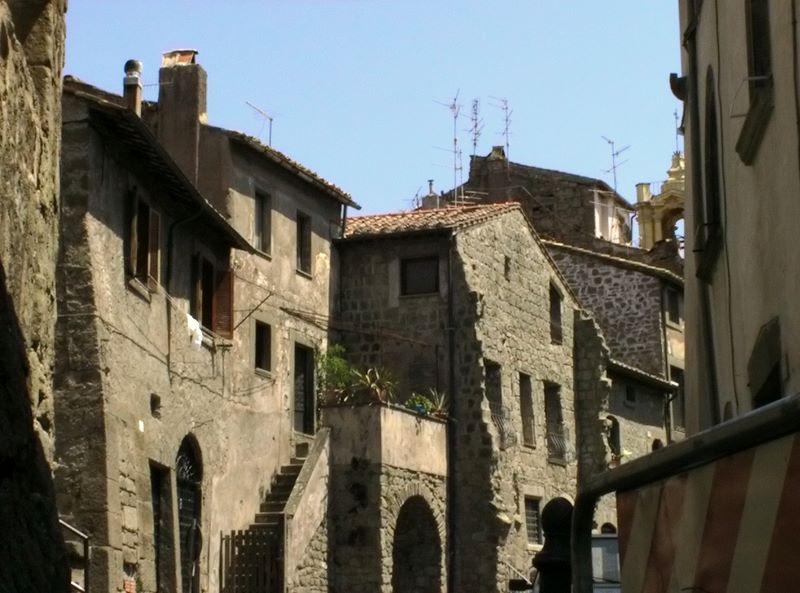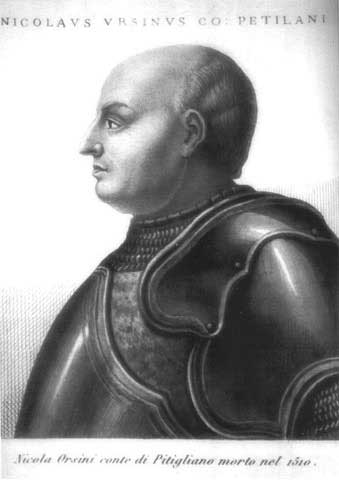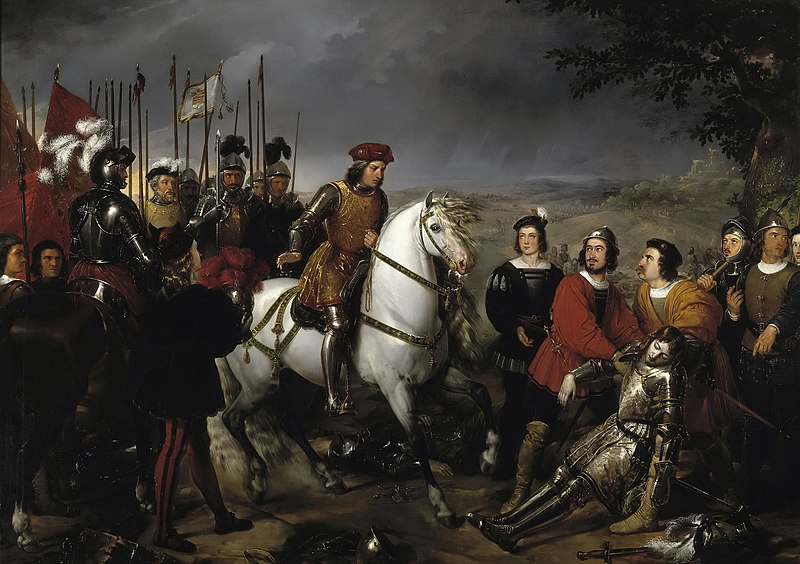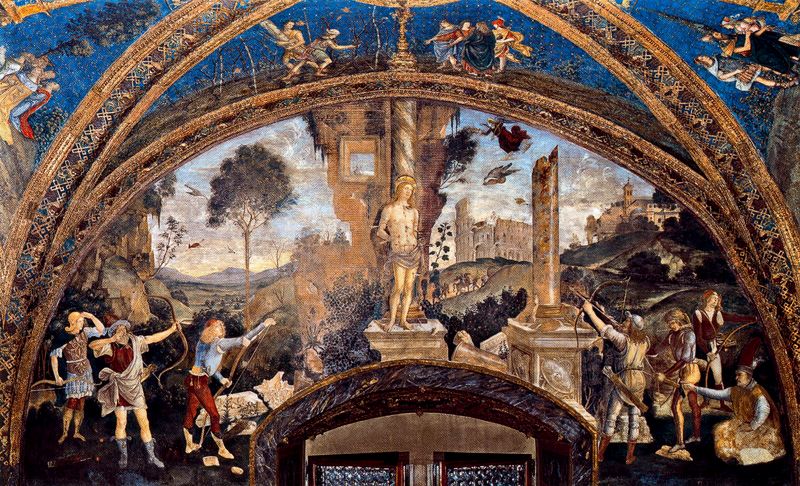 |
| Pietro Bembo |
1503 was to
be a momentous year for the Borgia family; Lucrezia began a long affair with
her brother-in-law Francesco II Gonzaga, Marquess of Mantua[i]. She also had an affair
with the poet Pietro Bembo. For Cesare life was to be far more
exciting.
The 1st
January 1503 was the last day of life for the traitors Euffreducci &
Vitelli, both garrotted by Michelotto. Later that day Cesare marched his troops
out of Senigallia and accompanying them were three of the Orsini, Paolo,
Roberto and the young Francesco, Duke of Gravina. Paolo’s young son Fabio
managed to escape.
The three
Orsini were in chains and their kin in Rome were being rounded up by Rodrigo’s
troops. Cardinal Orsini was arrested on 3rd January;
 |
| Torre di Nona |
‘The cardinal rode to the
Vatican….He himself entered the Sala del Pappagallo, only to find himself
surrounded by armed men, and in great fear was escorted to the Bishop of
Carinola’s apartment at the prison of the Torre di Nona[ii].’[iii]
The Archbishop of Florence Rinaldo Orsini was arrested later in
the day along with Jacopo di Santa Croce and Bernardino Orsini, the Abbot of Alviano.
Attacks and Counter-attacks
 |
| Ponte Nomenatano |
Within three
days of leaving Senigallia Cesare was master of the Vitelli stronghold Città di
Castello along with the Euffreducci town of Fermo. Baglioni fled Perugia which
fell uncontested into Cesare’s hands.
Meanwhile
the Orsini family had rallied and from a number of family strongholds planned a
counter-offensive against Rome. The men that Cesare left in the city turned the
Orsini attack back at the Ponte Nomentano and the Orsini withdrew, taking with them Cardinal Ippolito
d’Esté, who had recently added Cesare’s mistress Fiametta and Joffré’s wife
Sancha to his long list of conquests. He left;
‘To avoid the anger of Duke
Cesare….the cardinal was having an affair with the princess [Sancha] who was
married to Cesare’s brother and that the duke himself was also having an affair
with this woman.’[iv]
A frightened
Rodrigo demanded the return of Cesare’s army to Rome.
 |
| Viterbo |
On 18th,
as his troops entered the foothills of northern Tuscany, Cesare had Paolo
and Francesco strangled by Michelotto. At the same time he released Roberto
Orsini for reasons unknown. Cesare signed an alliance with the Bentivoglio of
Bologna on 20th January. Three days later the news reached Rome that
Cesare’s troops had taken Chiusi, Pienza, Sarteano and San Quirico d’Orcia.
Outside
Siena Cesare’s men prepared to besiege the city; Cesare offered the local
tyrant Pandolfo Petrucci free passage out of the city. But when Petrucci left
he was wily enough to beware Cesare’s offer and escaped to take refuge in Lucca. Cesare and his men turned towards Rome, stopping to regroup at Viterbo.
A Family Quarrel
 |
| Niccolo Orsini |
A breach appeared
in the family; Rodrigo who wanted to turn the papal troops against the last few
remaining Orsini strongholds at Bracciano, Ceri[v], Cerveteri and Pitigliano. Cesare disagreed, believing that
such attacks could turn friends into enemies. Louis regarded the Orsini lords
of Bracciano and Pitigliano[vi] as friends, while Venice
employed Niccolò Orsini as a condotta.
On 7th
February Rodrigo declared the Orsini rebels against the church[vii] and despatched artillery
to besiege Bracciano. When Cesare objected Rodrigo threatened his son with the
loss of all his fiefs. Reluctantly Cesare ordered his men into the fray, but
chose the less well defended Ceri to attack.
Cesare
returned to Rome in time to enjoy the pre-Lent carnival and spent much time
indulging in carnal pursuits.
The 15th
February saw the Venetian ambassador reporting that Cardinal Orsini had become
delirious; he was dead by 22nd, possibly poisoned, as rumour had it,
by Cesare or Rodrigo. Rodrigo informed his cardinals that Cardinal Orsini had
offered 25,000 ducats[viii] in return for his
freedom; his reply had been
‘To urge the cardinal to be
of good spirits and to take care only for his health. He [Rodrigo] had told him
that all other matters would be dealt with as soon as he was strong again. All
the doctors who could provide the cardinal with the best attention for his
recovery had been sent to him.’[ix]
The Balance of Power Tips| Pitigliano |
In late
February Pisa offered to make the city subject to Cesare in return for
assistance in its fight to free itself from the overlordship of Florence.
Louis, worried that Cesare would become too powerful, set up a league between
of Florence, Lucca, Bologna and Siena. He made the cities his allies and wards
and therefore safe from Cesare’s roving eyes. This only served to exacerbate
the differences between Rodrigo and his son.
On 6th
April, following mounting threats from his father, Cesare left the fleshpots of
Rome and made his way to Ceri. En route he was met by the news that Giulio
Orsini had surrendered the town, the defences having been battered to bits by
Cesare’s artillery. Giulio had received a letter from Louis urging him to give
up. Giulio agreed to give up the family possessions nearest Rome and he and his
family were allowed safe passage to Niccolo Orsini’s base at Pitigliano.
 |
| Cordoba after the battle |
Louis was
worried about the situation in Naples; his accord with the Spanish was breaking
down and clashes between the two armies were increasing along the agreed
borders of their territories. By April the situation was becoming dire and the 28th
April 1503 saw the French and Spanish armies fight it out at the Battle of Cerignola; the Spanish, led by Gonzalo de Cordoba, fought a larger French army and
won.
Dreaming of Naples
Rodrigo did
not want the Spanish to have a foothold on the Italian peninsula. He was not on
good terms with King Ferdinand and Cesare’s hold on power in the Romagna was
underwritten by the French. To help fund Cesare’s military endeavours on 31st
May Rodrigo created another nine cardinals[x]; the Venetian ambassador
calculated;
 |
| Louis de la Tremoille |
‘All paid generously for
their titles…..120,000 to 130,000[xi]
ducats; and if we add the 64,000 ducats raised from the sale of posts in the
Curia, and the legacy of Cardinal Michiel[xii], we have a large sum…Pope
Alexander shows us that a pope’s income can be as high as he wants.’[xiii]
Louis’
hunger for Naples was undiminished and, despite his losses in April, he created
a new army in Parma under the leadership of Louis de la Trémoille. To win the prize he coveted Louis
estimated that he needed Borgia assistance and now he found the Borgias
demanding a heavy price for their involvement. The price was too high and ended
with an uneasy neutrality; the Spanish took Naples in mid-May, replacing France
as the dominant power in Europe.
Death of a Pater Familias
The weather
in Rome that summer was unseasonably hot and saw an outbreak of malaria. Rome
had a new governor – Michelotto, who used his position to extort monies from
wealthy Spanish citizens, accusing them of being marrani[xiv].
He also forced Jews to pay for protection from harassment.
Rodrigo’s
fifty year old (and fat) nephew Cardinal Juan Borgia died on 5th
August; he was sick with syphilis but it was believed that he died from a
fever. The same day Rodrigo and Cesare attended a party given by Adriano Castelli da Corneto, a one-time secretary of Rodrigo’s.
 |
| Death of St Sebastien, detail from Borgia apartments in the Vatican |
On 7th
the Venetian ambassador paid a visit to Rodrigo and found him enveloped in a
shawl, despite the overwhelming heat. On 11th August Castelli fell
ill; the following day Rodrigo rose. After saying mass he took breakfast and
then retired to bed after vomiting. Cesare, who was about to leave Rome, fell
sick about the same time. He managed to return to his quarters before
collapsing.
‘Fourteen ounces of blood
were taken from him [Rodrigo] three days later and tertiary fever[xv]
set in. Early on August 17th he was given some medicine, but he
worsened and at about six o’clock, on the following morning, he made his
confession…..he expired in the presence of the datary, the bishop [of Carinola]
and the attendants standing by.’[xvi]
Burchard
informs us that Cesare then sent Michelotto to secure the pope’s apartments;
his men seized all the silver and two coffers containing 100,000 ducats[xvii].
Bibliography
At the Court
of the Borgia – Johan Burchard, Folio Society 1990
Lucrezia
Borgia – Rachel Erlanger, Michael Joseph 1979
Florence and
the Medici – JR Hale, Phoenix Press 2001
The Rise and
Fall of the House of Medici – Christopher Hibbert, Folio Society 2001
The Borgias
– Mary Hollingsworth, Quercus Editions 2014
The Borgias
– GJ Meyer, Bantam 2013
A History of
Venice – John Julius Norwich, Penguin Books 1982
Absolute
Monarchs – John Julius Norwich, Random House 2011
A
Renaissance Tapestry – Kate Simon, Harrap 1988
The March of
Folly – Barbara Tuchman, Cardinal 1990
Niccolo’s
Smile – Maurizio Viroli, IB Tauris & Company Ltd 2001
www.wikipedia.en
[i]
The passionate affair ended when Francesco contracted syphilis
[ii]
Formerly an Orsini stronghold and at this time used as a papal prison
[iii]
At the Court of the Borgia - Burchard
[iv]
The Borgias - Hollingsworth
[vii]
Thereby incurring automatic excommunication
[viii]
In 2013 the relative: historic standard of
living value of that income or
wealth is £16,260,000.00 economic status
value of that income or wealth is £465,400,000.00 economic power value of that income or wealth is £6,491,000,000.00 www.measuringworth.com
[ix]
At the Court of the Borgia - Burchard
[x]
Giving him 70% of the college
[xi]
The value of £184,000 0s 0d in Income or Wealth , in 1503 there are three choices. In 2013 the
relative: historic standard of living value of that income or wealth is £119,700,000.00 economic status value of that income or wealth is £3,425,000,000.00 economic power value of that income or wealth is £47,780,000,000.00 www.measuringworth.com
[xii]
A nephew of Pope Paul II and a prisoner in Castel Sant’Angelo who died after
two days of violent vomiting
[xiii]
The Borgias - Hollingsworth
[xv]
Malaria
[xvi]
At the Court of the Borgia - Burchard
[xvii]
In 2013 the relative: historic standard of
living value of that income or
wealth is £65,040,000.00 economic status
value of that income or wealth is £1,862,000,000.00 economic power value of that income or wealth is £25,970,000,000.00 www.measuringworth.com
No comments:
Post a Comment
Note: only a member of this blog may post a comment.